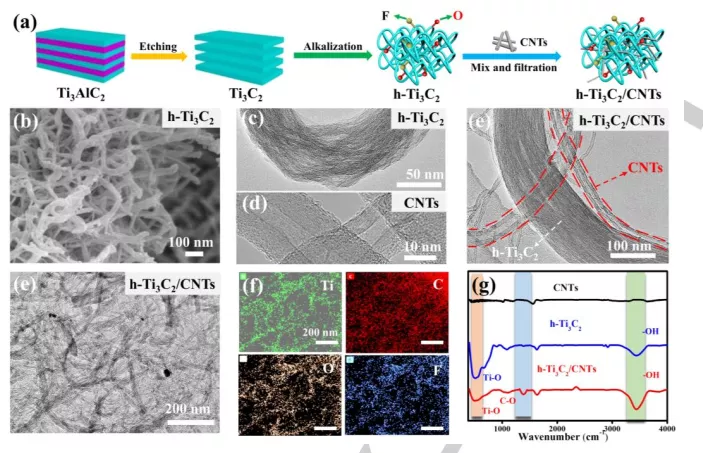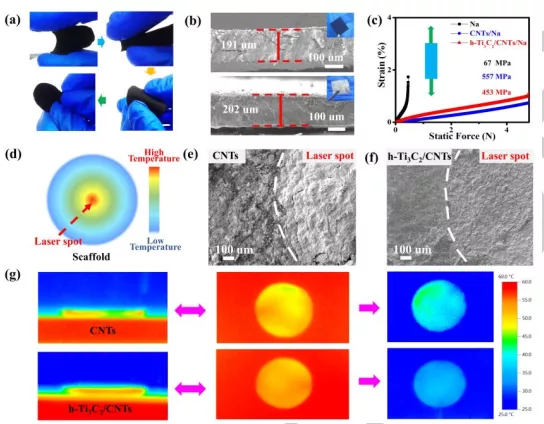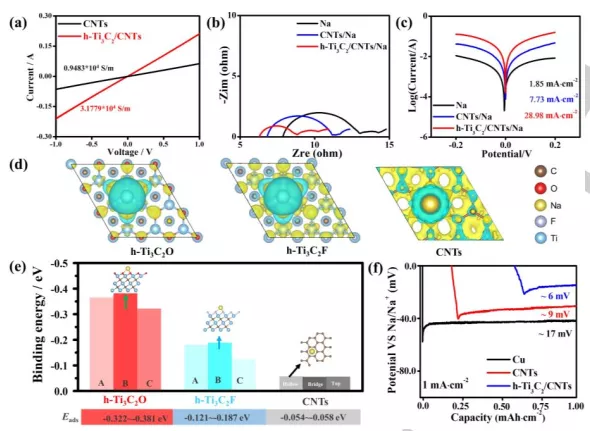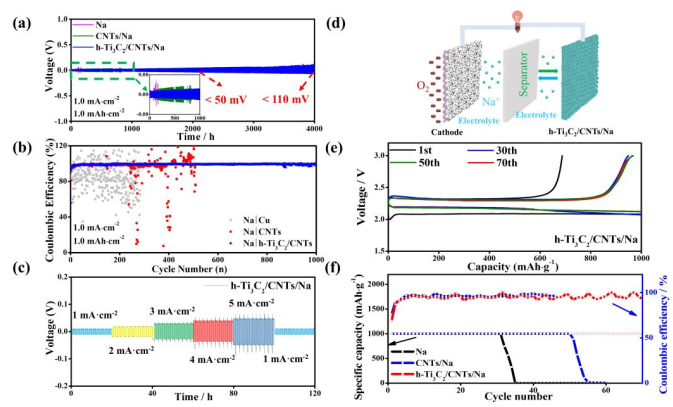Angew: three-dimensional hydroxylated MXene/carbon nanotube dendrite-free nano metal electrode
QQ Academic Group: 1092348845
Detailed

Sodium has the advantages of high abundance and high theoretical specific capacity of 1166 mAh·g-1, and is expected to become a very attractive negative electrode in the design of lithium batteries. However, like the lithium metal electrode, the sodium metal electrode has problems of low coulombic efficiency, poor cycle stability, and great safety risks due to uncontrolled dendrite formation during the sodium deposition process. In order to solve this problem, people have proposed methods such as using nano-scaffolds, optimizing electrolytes, and designing artificial protective layers. However, these developments are still difficult to meet the practical application requirements of metal sodium electrodes. In general, non-uniform Na deposition depends to a large extent on current density, Na+/electron transport kinetics, and the non-uniform distribution of salt-philicity (nucleation barrier or local potential). In addition, recent studies have shown that the local high temperature of the electrode can easily trigger the growth of lithium dendrites. Compared with the two-dimensional MXene material, the hydroxylated MXene material has a fibrous morphology, more hydroxyl/fluorine group content, and has a higher electrical conductivity and thermal conductivity. Previous studies have shown that loading oxygen functional groups can improve the salt/lithophile properties of the carbon host, thereby making the overpotential of Na/Li nucleation relatively low.

Recently, the team of academician Chen Jun of Nankai University published a research paper titled: 3D hydroxylated MXene/carbon nanotubes composite as scaffold for dendrite-free sodium-metal electrode in the internationally renowned academic journal Angewandte Chemie International Edition, reporting fibrous hydroxyl groups Ti3C2/CNTs (h-Ti3C2/CNTs) composites are used as a flexible and stable 3D matrix for uniform Na nucleation without dendrite growth. The composite material has rich salt-philicity, good thermal conductivity, fast Na+/electron transport kinetics and excellent mechanical properties.


Figure 1. (a) Schematic diagram of synthesis of h-Ti3C2/CNTs (b-g) morphological characterization of corresponding materials
Figure 2. (a) Flexibility of h-Ti3C2/CNTs/CNTs films (b) Cross-sectional SEM images of h-Ti3C2/CNTs/CNTs and h-Ti3C2/CNTs/CNTs/Na (c) Mechanical properties of different metal electrodes (D) Schematic diagram of the temperature distribution of the stent heated by laser (e and f) The corresponding SEM images of Na deposited on CNT and h-Ti3C2/CNTs films (top view) (g) Thermal conductivity of CNT and h-Ti3C2/CNTs films rate

Figure 3. Electrochemical characterization and DFT calculation results of h-Ti3C2/CNTs.

Figure 4. (a) In-situ XRD spectral contours on Cu current collectors, CNTs scaffolds and h-Ti3C2/CNTs composite scaffolds during the first deposition of Na (b) Na electrode, CNTs/Na electrode and (c) H-Ti3C2/CNTs/Na cross-sectional in-situ optical microscope photographs during stripping (1h) and re-plating (1h)

Figure 5. (a) Voltage curves of Na, CNTs/Na and h-Ti3C2/CNTs/Na symmetrical cells (b) Cu-CNTs and h-Ti3C2/CNTs scaffold electroplating-stripping Coulomb efficiency (c) h-Ti3C2 /CNTs/Na electrode rate performance in symmetric battery (d) Schematic diagram of Na║O2 battery (e) With h-Ti3C2/CNTs/Na electrode at a current density of 500 mA·g-1 for Na║O2 battery Charge-discharge curve (f) Coulomb efficiency and discharge capacity using different sodium metal electrodes at a current density of 500 mA·g-1

This paper demonstrates a flexible and stable 3D h-Ti3C2/CNTs matrix with excellent mechanical properties, good thermal conductivity, high basophilic sites and fast Na+/electron transport kinetics, which can be used as a support for Na negative electrodes. This effectively regulated the nucleation of metallic sodium and inhibited the growth of sodium dendrites. The hydroxylated fibrous MXene (h-Ti3C2) with certain oxygen affinity and fluorine functional groups plays an important role in reducing the nucleation overpotential and inducing uniform nucleation of Na. At the same time, CNTs have film-forming properties, tensile strength and excellent conductivity. Therefore, h-Ti3C2/CNTs scaffolds exhibit excellent electrochemical performance, and the average CE after 1000 cycles is about 99.2%. The symmetrical battery based on h-Ti3C2/CNTs/Na can maintain stable plating/peeling performance and even at higher capacity (5 mAh·cm-2) and high current density (10.0 mA·cm-2) Excellent cycle life. In addition, the Na-O2 battery with h-Ti3C2/CNTs/Na negative electrode showed a low potential difference of 0.11 V after 70 cycles. This work provides inspiration for the development of Na metal electrodes for high-energy and high-power battery systems.
Literature link:
https://doi.org/10.1002/anie.202006783
Source: MXene Frontie
This information originates from the Internet for academic exchange only. If there is any infringement, please contact us to delete it immediately
- Previous: MXene sends Nature Com
- Next: IF 20.3! Injectable li


 mxene academic
mxene academic
